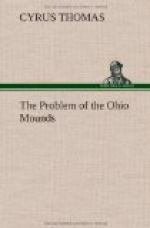The largest of these groups is situated on the Little Tennessee above Fort London and corresponds with the position of the ancient “beloved town of Chota” ("Great Chote” of Bartram) as located by tradition and on both Timberlake’s and Ramsey’s maps. According to Ramsey, [Footnote: Annals of Tennessee, p. 157] at the time the pioneers, following in the wake of Daniel Boone near the close of the eighteenth century, were pouring over the mountains into the valley of the Watauga, a Mrs. Bean, who was captured by the Cherokees near Watauga, was brought to their town at this place and was bound, taken to the top of one of the mounds and about to be burned, when Nancy Ward, then exercising in the nation the functions of the Beloved or Pretty Woman, interfered and pronounced her pardon.
During the explorations of the mounds of this region a peculiar type of clay beds was found in several of the larger mounds. These were always saucer shaped, varying in diameter from 6 to 15 feet, and in thickness from 4 to 12 inches. In nearly every instance they were found in series, one above another, with a layer of coals and ashes between. The series usually consisted of from three to five beds, sometimes only two, decreasing in size from the lower one upward. These apparently marked the stages of the growth of the mound, the upper one always being near the present surface.
The large mound which is on the supposed site of Chota, and possibly the one on which Mrs. Bean was about to be burned, was thoroughly explored, and found to contain a series of these clay beds, which always showed the action of fire. In the center of some of these were found the charred remains of a stake, and about them the usual layer of coals and ashes, but, in this instance, immediately around where the stake stood were charred fragments of human bones.
As will be seen, when the report which is now in the hands of the printer is published, the burials in this mound were at various depths, and there is nothing shown to indicate separate and distinct periods, to lead to the belief that any of these were intrusive in the true sense. On the contrary, the evidence is pretty clear that all these burials were by one tribe or people. By the side of nearly every skeleton were one or more articles, as shell masks, engraved shells, shell pins, shell beads, perforated shells, discoidal stones, polished celts, arrow-heads, spearheads, stone gorgets, bone implements, clay vessels, or copper hawkbells. The last were with the skeleton of a child found at the depth of 3 1/2 feet. They are precisely of the form of the ordinary sleigh-bell of the present day, with pebbles and shell-bead rattles.
That this child belonged to the people to whom the other burials are due will not be doubted by any one not wedded to a preconceived notion, and that the bells are the work of Europeans will also be admitted.
In another mound a little farther up the river, and one of a group probably marking the site of one of the “over-hill towns,” were found two carved stone pipes of a comparatively modern Cherokee type.




